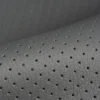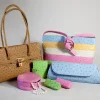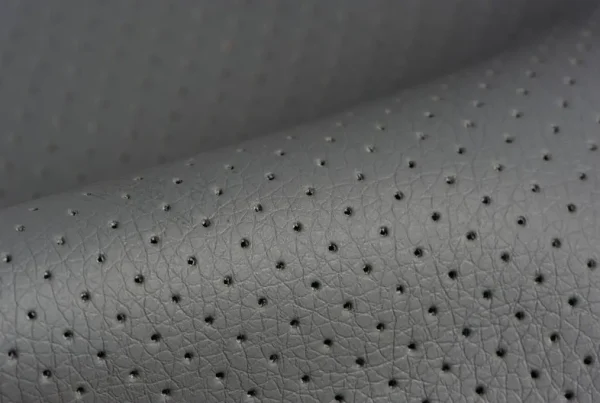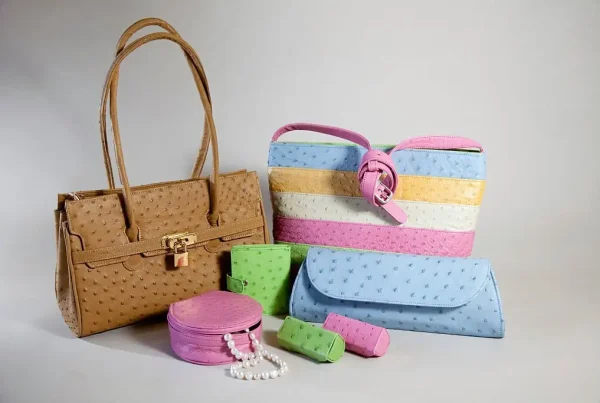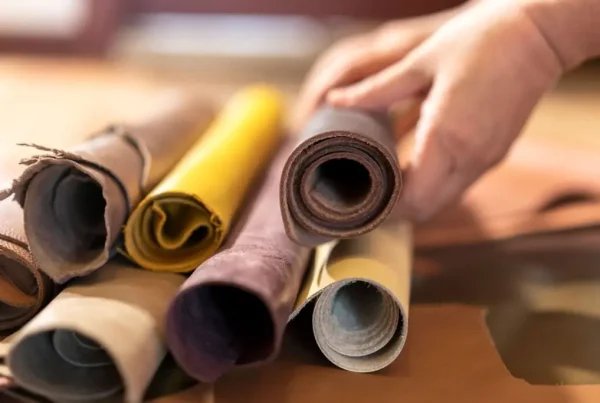In the realm of leather craftsmanship, pebbled leather reigns supreme with its unmistakable pebble-like finish. This unique texture sets it apart, making refine pebble leather a symbol of individuality and style in the world of fine leather goods.
What Is Pebbled Leather?
Pebbled leather is leather with a pebble-like finish. Tanneries create this textured look by applying heat or pressure to the leather, resulting in a unique pebbled pattern. Remarkably, this technique can be used on both real animal leather and its faux counterparts.
Origins of Pebbled Leather
The story of pebbled leather traces back, some say, to Scotland. Legend has it that a native tanner stumbled upon this technique in the 18th century when hides left on an uneven workshop floor developed a refine pebble leather texture under pressure. However, the method was patented in the 19th century by Mr. C.T. Woodman of Boston, Massachusetts, revolutionizing the industry. Pebbled leather eventually found its way into high fashion, becoming iconic in brands like Chanel and Gucci.

Benefits of Pebbled Leather
Distinctive Appearance:
Pebbled leather stands out with its remarkable pebble-like finish, setting it apart as an instant eye-catcher in the fashion world. The unique texture adds depth and character to any leather item, making it a statement piece that commands attention and admiration. Its ability to catch and play with light gives it a dynamic quality that elevates the aesthetics of fashion products.
Scratch Resistance:
Pebbled leather excels in durability, especially in its resistance to scratches and minor scuffs. This impressive feature is attributed to its texture and the grainy surface it presents. The pebble pattern, with its partially raised surface and irregular patterning, effectively conceals minor blemishes, ensuring that the leather retains its pristine appearance even in the face of daily wear and tear. This durability enhances the longevity of leather goods, making them reliable and long-lasting investments.
Sustainability Contribution:
Beyond its visual and functional appeal, pebble leather plays a pivotal role in promoting sustainability within the leather industry. It also reduces waste by embracing blemished or imperfect leather pieces. Pebble patterns revitalize and give these pieces a new purpose, reducing waste and making the leather industry more responsible. Refined pebble leather aligns with the principles of eco-conscious consumers who seek products with a lower environmental footprint.
Uses of Pebbled Leather
In Footwear:
Pebble leather boasts a rich history in the realm of footwear. It has adorned everything from timeless brogues to robust Dr. Marten’s boots, seamlessly combining style with exceptional durability. This long-standing presence in the shoe industry attests to its enduring appeal.
In Upholstery:
The versatility of this textured leather extends into the realm of upholstery, where it graces various items, including living room furniture, car seats, and even bar stools. Its presence in these everyday surroundings adds an element of sophistication and elegance, transforming ordinary spaces into inviting, comfortable settings.

In Sports Equipment:
Within the world of sports, pebble leather plays a crucial role in American footballs. Its distinctive cowhide texture serves a vital purpose by assisting players in maintaining a firm grip on the ball. This unique feature contributes to the effectiveness and performance of athletes in the game.
Versatile Consumer Goods:
Beyond these niches, pebble leather’s versatility shines through in a wide array of everyday consumer goods, from fashion accessories to luxury leather bags and beyond.
By incorporating these keywords and subheadings, we maintain clarity and readability while discussing the benefits and uses of refine pebble leather.
How Pebble Grain Leather Is Made
Modern Production Process:
The creation of pebble-grain leather involves a contemporary process that starts with raw hides and culminates in the embossing of the distinctive pebble-like texture. This process combines traditional craftsmanship with modern techniques to achieve the desired result.
Key Stages of Production:
The production of pebble-grain leather includes several key stages. It begins with the selection of high-quality raw hides. These hides undergo a tanning process, during which chemicals are used to transform the raw hides into durable leather. Next, the leather is dyed to achieve the desired color. The final and crucial step is the embossing process, where the leather is pressed with extreme heat or pressure to create the iconic pebbled pattern. This pattern is carefully etched onto the leather, giving it its unique texture.
Variety of Finishing Treatments:
Once the pebble-grain texture is achieved, various finishing treatments are applied to the leather. These treatments can serve different purposes, such as making the leather hydrophobic (waterproof), adding a glossy finish, making it fire-retardant, or even buffing it to create a soft, suede-like surface. These finishing touches not only enhance the leather’s appearance but also contribute to its functionality and durability.
Durability of Pebbled Leather
Quality Matters Most:
When considering the durability of pebble-grain leather, the primary factor to take into account is the quality of the leather itself. High-quality, full-grain leather is exceptionally robust and long-lasting. It is taken from the strongest part of the animal’s hide, making it inherently durable. This durability is not compromised by the pebbled texture, which is achieved without sacrificing the leather’s integrity.
Examples of Leather Types:
To illustrate the point, let’s consider different types of leather. Full-grain leather, known for its strength and resistance to wear and tear, is a prime example of durable leather. On the other hand, lower-quality cuts of leather, often derived from weaker sections of the hide, may have a shorter lifespan. Regardless of whether they are smooth or textured, the quality of the leather itself remains the key determinant of durability.
Pebbled Effect and Durability:
It’s essential to emphasize that the pebbled effect, despite its unique appearance, does not compromise the durability of the leather. Whether you choose smooth leather or pebble-grain leather, the longevity of the product is fundamentally determined by the quality of the leather used.
How to Care for Pebbled Leather
Cleaning and Conditioning Tips:
To ensure the longevity of your pebble leather items, it’s essential to clean and condition them regularly. Use a clean, damp microfiber cloth to gently remove dirt from the surface. Prior to applying to the entire leather piece, always conduct a patch test on a concealed section. For tougher dirt, consider using a soft-bristled brush, but be gentle to avoid damaging the texture. Remember, leather conditioners are your friend; they prevent the leather from drying out over time.
Natural vs. Faux Pebbled Leather:
Understanding the difference between natural and faux pebble leather is crucial. While natural refined pebble leather benefits from conditioning, avoid using conditioners on faux leather. Unlike natural leather, synthetic variations lack open pores for absorbing conditioner, potentially causing a sticky buildup.

Leather Care Products:
Choosing the right leather care products is essential. Spend time finding a cleaner specifically designed for your type of leather and always perform patch tests with new products. A light polish is recommended to be applied over wax to prevent buildup in the textured grooves.
Pebbled Leather in Contemporary Fashion
Trending in Fashion:
Pebbled leather is currently making waves in the world of fashion. Its unique pebble-like finish has caught the attention of designers and fashion enthusiasts alike.
Brands and Designers:
Several renowned brands and designers have embraced pebbled leather in their collections. From high-end fashion houses to contemporary labels, many are incorporating this textured leather into their creations.
Complementing Modern Styles:
Pebbled leather’s textured charm complements modern style preferences. Whether it’s in the form of sleek handbags, stylish boots, or chic accessories, pebbled leather adds a touch of sophistication to contemporary fashion.
The Future of Pebbled Leather
Evolving Role in Fashion:
The role of pebbled leather in the fashion industry is ever-evolving. Its distinctive pebble-like finish continues to capture the imagination of designers and consumers, ensuring it remains a prominent player in the world of textured leather.
Emerging Trends and Innovations:
As fashion evolves, so does the use of pebbled leather. Emerging trends and innovations in the leather industry may bring new variations of pebble-grain leather or innovative ways to incorporate its texture into fashion. Keeping an eye on these developments is essential for fashion enthusiasts.
Stay Updated:
Encouraging readers to stay updated on the dynamic world of refined pebble leather is crucial. Whether through fashion magazines, online blogs, or following their favorite designers, staying informed about the latest trends and innovations ensures they can embrace this textured leather’s timeless charm.
FAQs:
Is pebbled leather real leather?
Yes, pebbled leather is real leather that has undergone a texturing process to create its distinctive pebble-like finish.
What is pebbled vegan leather?
Pebbled vegan leather mimics the texture of pebbled leather for those who prefer cruelty-free options.
Is Pebble leather good leather?
Pebble leather is a good quality leather due to its durability, resistance to minor scuffs, and distinctive appearance.
What are the advantages of pebble leather?
The advantages of pebble leather include its unique texture, scratch resistance, and its ability to revitalize leather pieces that would otherwise be discarded.
Which is better smooth or pebble leather?
Whether smooth or pebbled leather is better depends on personal preference. Smooth leather offers a classic, sleek look, while pebbled leather adds texture and character to items like bags and accessories.


